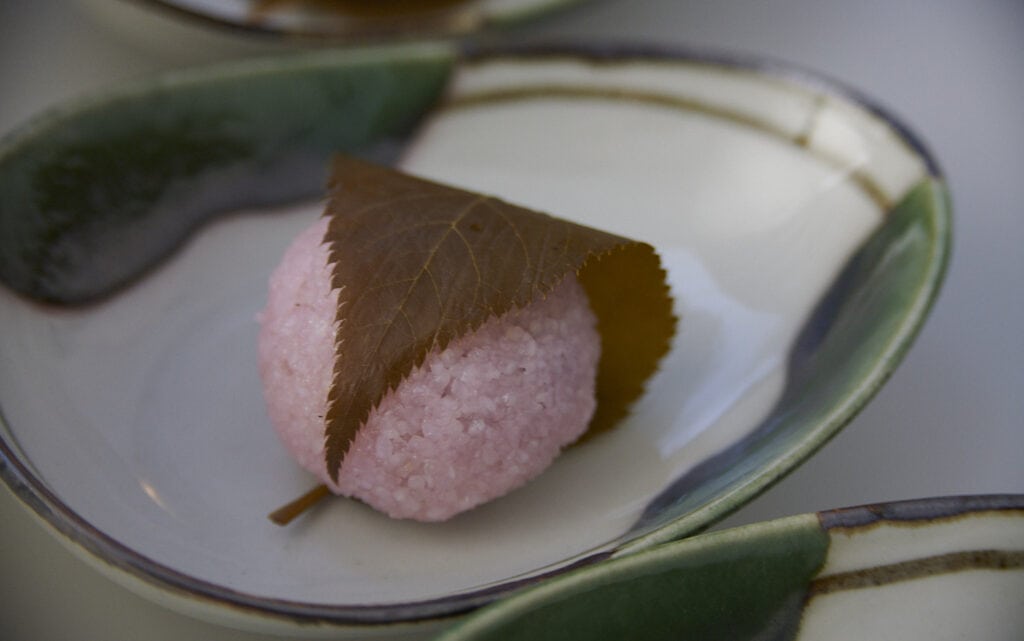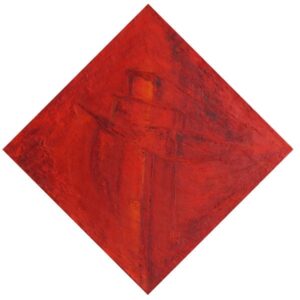Dōmyō-ji-ko (道明寺粉) is a special rice flour used in Japanese cuisine, especially for preparing sweet dishes such as dango (団子 - rice dumplings), mochi (餅 - rice cakes) and manjū (饅頭 - stuffed pasta).
It is made from glutinous rice and has a fine texture that makes it particularly suitable for making sticky or tough doughs.
The use of Dōmyō-ji-ko varies depending on the recipe, but it is generally mixed with other ingredients to make dough. For example, it is often mixed with (sometimes hot) water to make a batter for dango or mochi. Sometimes it is also combined with sugar or other sweet ingredients to make sweet pasta.
The use of Dōmyō-ji-ko enables the production of traditional Japanese sweets with the characteristic sticky texture and mild flavor typical of this type of dessert. It is an important element in Japanese cuisine and is often used in the preparation of seasonal specialties.
What is Dōmyō-ji-ko?
With our seasonal menus and events you can always try different techniques and flavors of the Japanese cuisine and we also sometimes work enthusiastically with special Japanese ingredients.
Dōmyō-ji-ko is a type of rice product made from mochi (sticky) rice. Some of you may remember that we used this Japanese flour in the wan mono and sakura mochi courses at the Hanagasumi Kaiseki in April 2023.
Variety of flours made from rice in Japan
Incidentally, in Japan, the land of rice, there are a variety of flours (or products known as "ko" (粉)) that are made from rice.
- Uruchi rice: Jyōshin-ko/上新粉 (for Dango/団子, Kashiwa-mochi/柏餅) Jyōyō-ko/上用粉 (for Jyōyō-manjyū/じょうよう饅頭)
- Mochi rice: Mochi-ko/餅粉 (for Gyūhi/求肥・Mochi sweets/餅菓子)
- Shiratama-ko/白玉粉 (for Shiratama-dango/白玉団子・
Gyūhi) - Dōmyō-ji-ko/道明寺粉 (Confectionery/生菓子)
- Mijin-ko/微塵粉 (decoration of sweets/菓子の装飾)
- Kanbai-ko/寒梅粉 (Rakugan/落雁・Craft sweets/
工芸菓子)
Various production options for rice flour
There are different production methods for flours made from mochi rice. Mochi-ko and shiratama-ko are made by washing the rice, soaking it in water and then grinding it with a stone mill. Dōmyō-ji-ko is made by soaking mochi rice, steaming, drying and coarse grinding. It is divided into six types depending on the size of the pieces, with the smaller the piece size, the smoother the product.
Mijin-ko or kanbai-ko is made by grinding the steamed product until it becomes finer, but it can also be made into a powder by rolling it into a mochi-like dough and baking it white.
Historical facts about Dōmyōji-ko
"Dōmyō-ji" in Dōmyōji-ko is the name of a temple in the city of Fujiidera, Osaka Prefecture (大阪府藤井寺市). It was built in 594 by the Haji family (土師氏), who once ruled this area, as a haji-dera (土師寺/temple) in honor of Amenohohi no Mikoto (天穂日命), who is worshipped as the god of negotiation, matchmaking and industrial prosperity.
His descendant, Sugawara Michizane (菅原道真), was an aristocrat, scholar, Chinese poet and politician of the Heian period who gained great trust and held important positions during the reign of Emperor Uda (宇多天皇). After the death of Emperor Uda, he continued to be highly respected and was promoted to minister (Udaijin/右大臣) in 899. Due to his unprecedented promotion, however, he became embroiled in a power struggle and was unjustly exiled to Dazaifu.
Before leaving Kyoto/capital, Michizane was allowed to stop at his aunt, a nun, Kakuju-ni (覚寿尼), who lived in Haji-dera, and carved a statue of himself and gave it to her. After his death, the temple was renamed Dōmyō-ji Temple and his belongings were enshrined as treasures in the main building.
The food that Kakuju-ni offered daily to his belongings (in Japan, food is offered at gravesites or alternatively to comfort the souls of the deceased and express gratitude to the deceased. After a certain period of time, the food is eaten as Osagari/お下り). To share the "osagari" with many people in Dōmyō-ji, mochi rice was steamed and dried. It was called "Dōmyō-ji-hoshi" (道明寺糒) and was useful as food for the army and for travelers. Later, "Dōmyō-ji-hoshii" was coarsely crushed and processed into a powder called "Dōmyōji-ko", which was used to make Japanese sweets.
Incidentally, Sugawara Michizane already showed a talent for science in his early childhood. He was regarded as the "God of Learning" and there are more than 10,000 Tenmangu shrines (天満宮) dedicated to him in Japan. Even today, he is still revered by many people, and during exam time, many students preparing for entrance exams visit Tenmangu shrines across the country.
Another theory on the origin of Dōmyō-ji-ko
A long time ago, a woman who lived near Haji-dera always thought it was a pity that the villagers threw away leftover grains of rice. So she collected the discarded rice grains and dried them in the sun. After storing the rice for a while, they found that the dried rice was not damaged, and when they steamed it again, they found that it was very tasty. After that, the villagers began to dry and preserve "Dōmyō-ji-hoshii" so that the rice would not be left over and thrown away after a meal.
Which sweets Dōmyō-ji-ko is used for
Now, what kind of cuisine or sweets is Dōmyō-ji-ko, which has such an interesting history, used for?
As the raw material is mochi rice, it becomes sticky when steamed and has a similar texture to mochi.
As mentioned above, there are different sizes of coarseness of pieces, and they are used according to purpose and preference.
The most representative sweet that Dōmyō-ji-ko uses is Kansai-style sakura-mochi. Kansai-style sakura-mochi is made by wrapping the sweet red bean paste in a dough made from Dōmyō-ji-ko. The sweet scent of cherry blossoms can be enjoyed as it is wrapped with cherry leaves. During the cherry blossom season, Japanese people not only enjoy the sight of cherry blossoms with their eyes, but also feel the spring while eating sakura-mochi.
Incidentally, the kanto-style sakura-mochi is made from wheat flour, rolled out in water, baked thinly and wrapped in sweet red bean paste. Like the kansai style, it is dyed pink and wrapped in cherry leaves, but looks more like a crepe. It also has a different texture because it doesn't use dōmyō-ji-ko.
Dōmyō-ji-ko can also be used to make dango (団子) and daifuku (大福). In contrast to making it with shiratama-ko, we can enjoy a unique texture.
It is also delicious when steamed or boiled dōmyō-ji-ko is used to cover or wrap white fish such as sea bream or Spanish mackerel or chicken. In Japanese cuisine, especially in Kaiseki-menus, it is often referred to as Mushi-mono or Ni-mono served. Sometimes it is also served as oshinogi.
"Dōmyō-ji-age" is deep-fried food that is dipped in egg white and Dōmyō-ji-ko, giving it a white, crumbly appearance. There are many varieties of deep-fried food, such as chicken and shrimp dōmyō-ji-age, and they impart a crispier texture than those deep-fried with flour or potato starch.
Gluten-free shaumai can also be made by steaming the meat and sprinkling it with Dōmyō-ji-ko instead of wheat flour, which gives it a sticky texture that is pleasant to eat.
Similar to the Dōmyō-ji-ko, we look forward to welcoming you to the Restaurant sansaro We will continue to present a variety of other ingredients and invite you on a short trip to Japan through our kitchen. We look forward to your visit!






